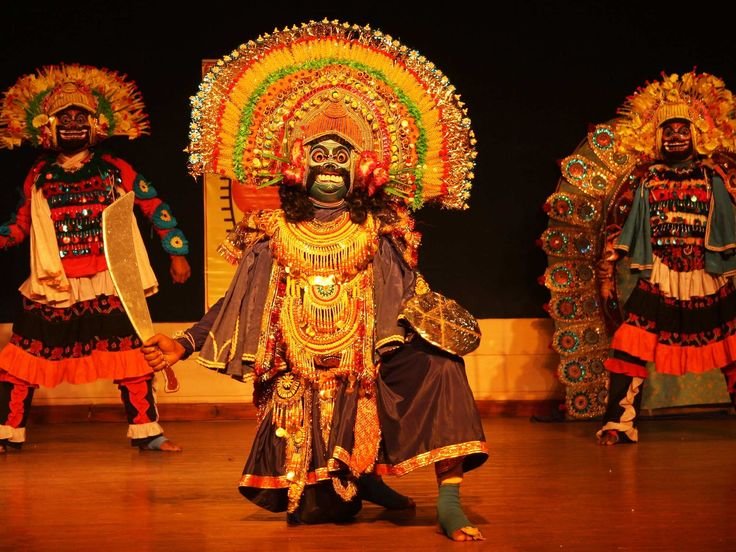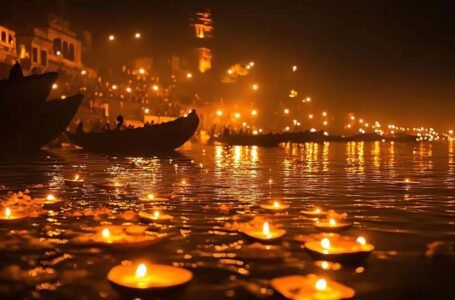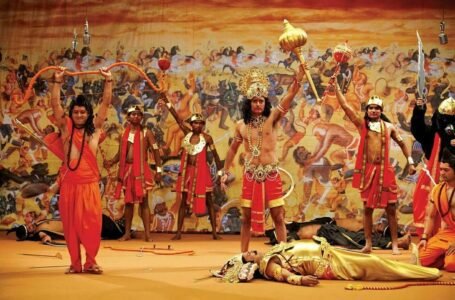Chhau Dance: A Traditional Martial Art Form with Tribal and Folk Origins

Chhau, also spelled as Chhou, is a semi-classical Indian dance form that blends martial arts, folk traditions, and classical influences. Predominantly performed in the states of West Bengal, Jharkhand, and Odisha, Chhau has three distinct styles named after their respective geographical regions: Purulia Chhau of West Bengal, Seraikella Chhau of Jharkhand, and Mayurbhanj Chhau of Odisha. Each style reflects its unique cultural essence while embodying common elements such as martial movements, acrobatics, and storytelling.
Chhau dance captures the spirit of celebration, martial vigor, and artistic expression, making it an integral part of the region’s socio-cultural identity. Traditionally performed by male troupes during festivals, particularly in spring, Chhau is known for its dynamic movements and engaging narratives that draw from Indian epics, folklore, and religious themes. Over time, however, traditional village-based performances have faced challenges due to the rise of commercialized and urbanized adaptations.
Etymology and Origins
The term “Chhau” is believed to have multiple origins. Some scholars trace it to the Sanskrit word Chāya, meaning shadow, image, or mask, while others associate it with Chadma, meaning disguise. Another interpretation links it to Chhauni, meaning military camp or stealth, reflecting the martial roots of the dance. Regardless of its etymology, Chhau’s origins are deeply rooted in the cultural and spiritual traditions of the tribes and communities of eastern India.
Chhau is thought to have evolved from a fusion of ancient tribal practices and classical Hindu dance traditions. The martial aspects of the dance, particularly its stylized movements and mock combat techniques, are inspired by the warrior ethos of the region. The lasya (graceful feminine movements) elements, on the other hand, are attributed to influences from the Natya Shastra, the ancient treatise on performing arts. Together, these elements create a harmonious blend of virility, elegance, and spirituality.
Styles of Chhau Dance
Each of the three styles of Chhau—Purulia, Seraikella, and Mayurbhanj—has distinct features, particularly in terms of mask usage, themes, and performance techniques.
- Purulia Chhau
Purulia Chhau, from West Bengal, is characterized by its vibrant masks, which are intricately designed to represent mythological characters. These masks, crafted by the Sutradhar community, are central to the dance’s visual appeal. The process of mask-making involves multiple stages, including shaping with clay, layering with paper and cloth, and decorating with colors and embellishments such as shola (pith). These masks bring life to characters from the Ramayana, Mahabharata, and Puranas.
Purulia Chhau is performed during the Sun Festival and other agricultural celebrations, symbolizing the transition between harvest cycles. The dance is accompanied by traditional folk music played on instruments such as the dhol, dhumsa, and mohuri. The themes often include tales of heroism, divine intervention, and moral values, making it both entertaining and spiritually uplifting.
- Seraikella Chhau
Seraikella Chhau, from Jharkhand, uses symbolic masks that focus more on abstract expressions than detailed storytelling. This style was historically patronized by the nobility of the Seraikella region, who contributed to its repertoire and choreography. Unlike Purulia Chhau, the masks in Seraikella are more minimalist, emphasizing the dancer’s movements to convey emotions and narratives.
The d’nce often blends martial techniques with representations of animals, birds, and everyday human activities. Seraikella Chhau is known for its refined elegance and has become a popular medium for artistic experimentation in contemporary times.
- Mayurbhanj Chhau
Mayurbhanj Chhau, from Odisha, stands out as the only style that does not use masks. Instead, it relies on facial expressions, body movements, and gestures to convey emotions and tell stories. This style is technically similar to Seraikella Chhau but places a greater emphasis on athleticism and fluidity.
Mayurbhanj Chhau performances are often held during the Chaitra Parva festival, a springtime celebration that involves the entire community. The themes range from episodes of Hindu epics to local legends and abstract concepts, reflecting the dance’s versatility and cultural richness.
Cultural and Spiritual Significance
Chhau dance holds a special place in the cultural fabric of the regions it originates from. Its performances are often linked to religious and agricultural festivals, bringing together people from diverse socio-economic backgrounds in a spirit of celebration and unity. The Chaitra Parva festival, for instance, is a major occasion for Chhau performances, where entire communities participate in the festivities.
The dance serves as a medium for storytelling, with narratives often derived from Hindu mythology, such as the Ramayana and Mahabharata. These stories are not only entertaining but also convey moral and philosophical lessons, making Chhau a form of cultural education as well.
Music and Instruments
Music plays a crucial role in Chhau performances, providing rhythm and enhancing the overall experience. The traditional ensemble includes reed instruments like the mohuri and shehnai, along with a variety of drums such as the dhol (cylindrical drum), dhumsa (kettle drum), and kharka or chad-chadi (small percussion instruments). The music is often lively and rhythmic, complementing the energetic movements of the dancers.
Modern Challenges and Preservation Efforts
In recent decades, Chhau dance has faced several challenges, including the decline of traditional village-based performances and the rise of commercialized versions. Urbanization and changing cultural preferences have contributed to this decline, as younger generations show less interest in traditional art forms.
To address these challenges, various government and non-government organizations have taken steps to preserve and promote Chhau. The Government of Odisha established the Government Chhau Dance Centre in Seraikella in 1960 and the Mayurbhanj Chhau Nritya Pratisthan in Baripada in 1962. These institutions provide training, organize performances, and support local artists.
The Sangeet Natak Akademi has also played a significant role in promoting Chhau, establishing a National Centre for Chhau Dance in Baripada, Odisha. Additionally, UNESCO recognized Chhau as a part of the “Representative List of the Intangible Cultural Heritage of Humanity” in 2010, bringing global attention to this unique art form.
Influence in Popular Culture
Chhau dance has occasionally found its way into popular culture, showcasing its artistic and aesthetic appeal to wider audiences. For instance, the Hindi film Barfi! Features scenes inspired by Purulia Chhau, highlighting its vibrant costumes and dramatic storytelling. Such representations have helped introduce Chhau to new audiences, both in India and abroad.
Conclusion
Chhau dance is more than just a performance art; it is a celebration of heritage, community, and spirituality. Rooted in the martial traditions and folk practices of eastern India, Chhau embodies the cultural richness and diversity of the region. While it faces challenges in the modern era, efforts to preserve and promote this dance form continue to ensure its relevance and vitality.
By blending storytelling, music, and dynamic movements, Chhau remains a testament to the creativity and resilience of India’s traditional art forms. As we embrace the future, it is essential to honor and support such cultural treasures, ensuring that their legacy endures for generations to come.


